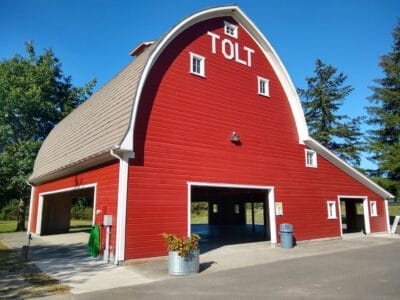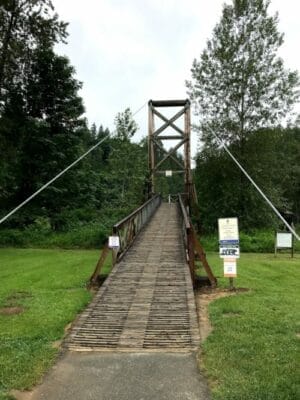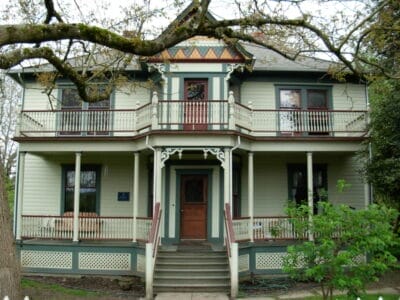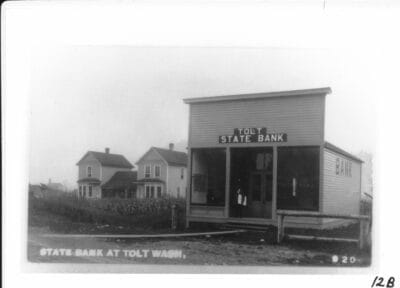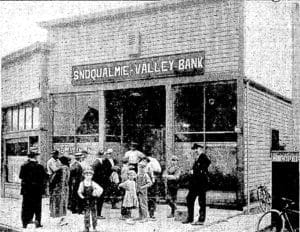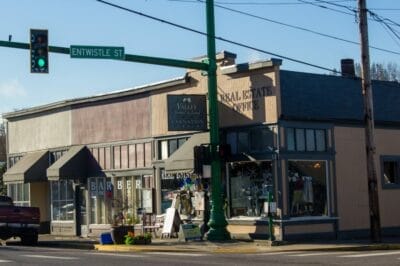Carnation Historic Walking Tour
Enjoy a walk through the historic town of Carnation and learn some of its history and secrets. Our self-guided tour of downtown Carnation is a fun way to learn about historic buildings and the stories they have to share. Click on the links for each of the stops to see historic photos. This Itinerary was developed with generous support from 4Culture with King County Lodging Tax Funds.
Itinerary
-
Tolt MacDonald Park
Start your day at Tolt MacDonald Park. This 574 acre park sits along both the Snoqualmie and Tolt rivers, serving as a popular spot for camping, hiking, and picnics. Once you find a parking spot, check out the beautifully restored barn. Then head west to the Snoqualmie River to check out the suspension bridge.
This impressive bridge was the vision of John MacDonald, the namesake of the park. This banker, Navy veteran of World War II, and volunteer for the Seattle Council of Boy Scouts of America had big dreams for the property King County acquired in 1964. Building a bridge would connect the two sides of the park split by the Snoqualmie River. MacDonald found help in the Army Reserves’s 40th Engineering Company, which worked on completing the 500-foot suspension bridge. Unfortunately, John died just a few months before project completion, but the bridge received the name Tolt-MacDonald in his honor.
-
Hjertoos Farm
Head east on the main entrance road that you drove in on (NE 40th Street). Soon the Hjertoos Farm (also known as the Carnation Tree Farm) appears down a gravel road on the right. In 1907, Bergette and Andrew Hjertoos (one of the first settler families to arrive in Carnation) built the beautiful Victorian home – The Hjertoos House, a King County Historical Landmark. In 2019 the Tolt Historical Society opened its museum in the house.
Continue on the gravel road to walk through the Hjertoos Farm and past the Hjertoos barn. The farm was developed in the 1880s among a wave of settlers. When the Hjertooses purchased the farm in 1901 from the Shaw family, it included a two-story log-house, a large house for boarders, and a substantial orchard. In 1907, the growing family built the two-story, wood frame farmhouse to replace the earlier structures. The elaborate two-story front porch, which had fallen into disrepair, was carefully reconstructed in 1988 based on historic documentation. The farm currently produces both Christmas trees and vegetables. Read the full history of the farm here.
-
Tolt Middle School
Continue walking through the farm until you arrive at Highway 203. Safely cross the highway.
The Tolt Middle School on the right sits on the site of the original Tolt High School. In 1914 the communities of Tolt, Stillwater and Pleasant Hill combined resources to construct a two-story brick high school. The school was completed in 1914, built on land donated by Andrew Hjertoos. Ralph W. Keller served as the first principal and the first graduating class, in 1915, included four students. The original school was demolished in 1971, making way for a new structure for students in grades 7-12. In 1993, high school students moved to the new Cedarcrest High in Duvall, leaving the Tolt Middle School for students in grades 6-8.

Photo credit: Tolt Historical Society -
Valley Memorial Park
Visit Valley Memorial Park next. You can get to the park through the Middle School. Stay along the northeastern side of the school and take a left into the park (about 120 feet off the highway).
The park sits on property originally part of the Entwistle family homestead. James Entwistle – the first settler in Carnation – arrived in 1858. A collaborative effort by the Valley Men’s Club and David Entwistle (James’ son) generated the idea for Valley Memorial Park in 1945. Volunteers constructed the park between 1945 and 1949 using donated materials. In 1947 a committee including representatives from the Men’s Club and the American Legion voted to install a World War II monument which still stands in the park today.
-
St. Anthony's Catholic Church
Head all the way east through the park and turn left on King Street, then take another left onto Blanche Street. You’ll soon arrive at St. Anthony’s Catholic Church.
Parishioners constructed St. Anthony Mission Church in 1914 with donations from the Catholic Extension Society. Tolt resident Ronald McDonald donated the land, and continued to live in the house west of the church. Initially the church only celebrated Mass monthly as the rest of the Monroe parish shared the priest. St. Anthony’s separated from the Monroe parish and acquired its own priest in 1929. After that, it held masses weekly and the size of the parish grew.
St. Anthony’s first Mass celebration occurred in the new building on November 6, 1914, and the Archbishop dedicated the church a week later. Rev. D.P. Kelly served as St. Anthony’s first priest from 1914-1918. Rev. Daniel Grace (1919-1924), Rev. Robert Dillon (1925-1926) and Rev. William Chaput (1927-1929) followed.

Photo Credit: Snoqualmie Valley Historical Museum -
Entwistle House
Next cross the street and head north on McKinley Avenue a few blocks and take a right on Entwistle St. After two and a half blocks you’ll arrive at the Entwistle House on the right.
David Entwistle constructed this home in 1912. David’s father James Entwistle – the first settler in Carnation – filed a claim of 160 acres along the Tolthue River (now referred to as the Tolt River) in 1858 under the Donation Land Act of 1850. He ended up converting much of his subsistence farmland to hops, then lost everything when the hops market bottomed out in October 1894. After this land’s foreclosure, James moved onto another property in Carnation that he had purchased. He drowned in 1902 in Seattle while visiting his daughter. He had been walking along the waterfront tracks and fell into the water at the approach of a train.

-
Tolt Grammar School
Cross to Commercial St and head northwest back to Tolt Avenue (State Route 203). Take a right on Tolt Avenue and head north two blocks to Carnation Elementary School.
The first school opened in Tolt in 1897 inside a log shack built on Shamgar Morris’s property north of the town. Called School District No. 27, it had a window on each side, a fireplace, and rough cedar benches instead of desks. A Mr. Hill (whose first name doesn’t appear in the historical record) taught four students who had to furnish their own books, pencils and paper. A second school house also on the Morris property used a box stove for heat and had rough double-seat desks. During a heavy snow winter in 1882, the third school built in Tolt began to function on the Prenatt farm. It had more windows than its two predecessors on the Morris property, included a playground, and employed a bell to call the students to class. Miss Bessie Thistlewaite (subsequently Mrs. James Prenatt) served as the first teacher, later succeeded by Margie Stafford. By 1893 this school was known as District 113.
1895 saw the construction of a new Tolt Grammar School at the present site of Carnation Elementary School. It operated independently from the school on the Prenatt farm. These two elementary schools, called District 27 and 113, finally combined in 1907 to form District 165. A total of 177 pupils attended the combined district with J.M. Weaver as Principal. The two story brick school building was torn down in November, 1934 because it was too small. A May 10, 1935 dedication ceremony celebrated the completion of a new replacement school.
-
Carnation Cemetery
The Carnation Cemetery borders the Carnation Elementary School to the north. This cemetery dates back to 1905 when Frederick B. Bagwell donated the land that is now the northern section of the cemetery. Bagwell headed up the cemetery association, entirely comprised of Masons, though the cemetery was open to everyone. The following year the International Order of Oddfellows started its own cemetery association, and its own cemetery, located south across a road from the Masons’ cemetery. Several burials pre-date the cemeteries’ origin – relocated from the nearby Pleasant Hill Cemetery after the 1905 establishment..
In 1957, the two cemeteries combined when the Oddfellows took control of the Masons’ portion. It remained in their possession until the the city officially assumed management in the mid-1990s.
-
Tolt Congregational Church
Next head south, back into town, and cross the street to the Tolt Congregational Church.
On December 30, 1936, fire destroyed the original wood frame Congregational Church – dedicated on August 8, 1898, and situated between the Tolt Grammar School and the cemetery. E.H. Stuart, of the Carnation Milk Farm, funded the design and construction of a new church in memory of his wife who had died in 1937. Dedicated as the Nan Fullerton Stuart Memorial Chapel on August 28, 1938, the Gothic Revival style building became the second Tolt Congregational Church. Features include granite quarried in Index, Washington, a design patterned after Scottish architecture, and a Celtic Cross top. The bell tower came from the original church.

Photo credit: Tolt Historical Society -
Miller's
Continue south on Highway 203 for two and half blocks to Miller’s – A Gathering Place. Built in 1925, this building originally served as a variety store owned by Albert Prenatt. Albert’s father Joseph Prenatt, an early homesteader, arrived in Tolt in 1868. in 1940, Albert Prenatt sold the store to Howard Miller, who renamed it Miller’s Dry Goods. Howard and Marion Miller ran the store until 1982. Miller’s Dry Goods was known throughout the Valley for providing clothing and equipment to farmers, loggers, and their families.

Photo credit: Tolt Historical Society -
Tolt State Bank
Walk one block further south on Highway 203 to Carnation Corners Valley Real Estate in a building originally built for Tolt State Bank in the early 1900s.
Eri Barber Colwes, an early Tolt settler, built the bank and served as the first bank president. He enlarged the building in 1915 where he established a post office and rented space to other businesses. Tolt State Bank expanded with the local affluence and changed its name to Snoqualmie Valley Bank in 1918.
In 1924 a robbery at the bank shook the town and Seattle for days. Read about it in our blog The Day Carnation Became the Wild, Wild West.
-
Tolt IOOF Hall
Continue heading south on Highway 203 back towards Tolt MacDonald Park. When you arrive at 40th Street, look across to the yellow building, originally built as a mens’ social club – the Independent Order of Odd Fellows (IOOF Hall) Lodge No. 148. The club started in Tolt on March 20, 1895.
The IOOF society originated in England during the 18th Century and spread to the United States with its lodge system. As one of several secret, self-governing groups popular in America at the time, it had ritualistic ceremonies and varied levels of member rank. The Tolt Odd Fellows held their first meeting in a two story building near the Snoqualmie River owned by James Entwistle. The $20.00 initiation fee contributed towards the construction of a meeting hall. They purchased a lot from George W. Shaw on the southeast corner of Tolt Avenue and NE 40th Street, and began construction. The Odd Fellows dedicated their new building on December 26, 1895.
After 30 years of meeting inside this building, the Odd Fellows felt they needed a larger meeting hall. They purchased a lot on the northeast corner of Stephens and Bird Streets from the Tolt Townsite Company on July 3, 1925 to construct a larger meeting hall. To meet an estimated $10,000 construction cost, the Odd Fellows managed to coordinate $5,000 in bonds, a majority of donated labor, and charitable assistance from their women’s auxiliary group – the Grace Rebekah Lodge. October 22, 1925 saw the first community dance in the new building. A predominant source of local entertainment at the time, community dances also provided a source of revenue for the sponsoring groups. The Tolt Odd Fellows held their first meeting in their new hall on January 14, 1926 and conducted a formal dedication ceremony on May 8th. On May 18, 1929, the Tolt Odd Fellows paid off all debts on the hall.
Gradually, secret fraternal societies including the Odd Fellows declined in the United States, supplanted by philanthropic service clubs such as the Kiwanis, Lions and Rotary, which admitted women. After 42 years of service, the Tolt Odd Fellows sold their meeting hall in 1971 and joined the Fall City Lodge. The meeting hall subsequently became the Sno-Valley Senior Center.

Photo Credit: Snoqualmie Valley Historical Museum -
Tolt MacDonald Park
Head west on NE 40th Street returning to the tour starting point. This concludes the walking tour, but you can extend the tour by car to visit Carnation Farms and the Vincent School House.
To get to Carnation Farms take Highway 203 north of Carnation and take a left onto Carnation Farm Road. You’ll cross over the Snoqualmie River and soon arrive at the farm on the right. Carnation Farms was created in 1908. Founder E.A. Stuart purchased the original 360 acres of farmland sight unseen based on a tip from his childhood friend Sam Hill that the railroad would soon connect to this part of the world. In purchasing this farm, his first priority was to increase the productivity of dairy herds. Stuart’s ideas fundamentally changed milk production, the town of Carnation, and the world of dairy.
After visiting Carnation Farms continue on the Carnation Farm Road to NE 80th Street and then turn right. Go across the flats and veer left at the fork. Turn right at the stop sign onto W Snoqualmie Valley Rd and the Vincent School House will immediately appear on the left. Residents built the schoolhouse in 1905 so their children could attend school close to their homes. The school housed all grade levels and included students from many pioneer families in the Snoqualmie Valley. About 20 students at a time attended the school. Teachers typically worked for two or three month terms in the fall and spring – seasons when parents could release the children from their farming duties to attend, and before harsher weather complicated travel for those from outlying farms. In 1942 the school closed, and the Vincent Community Club purchased it from the School District in 1943 for $1.00. King County designated it as a Historic Landmark in 1986.


